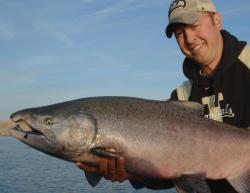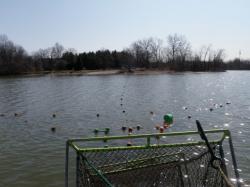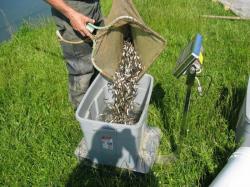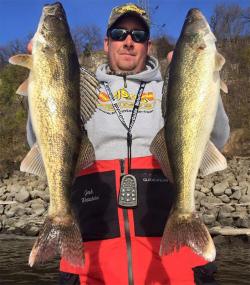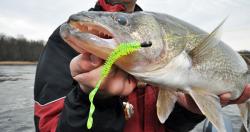Early Season Jerkbait Bass
Lessons learned in cold, clear waters
By Steve Pennaz
from The Fishing Wire
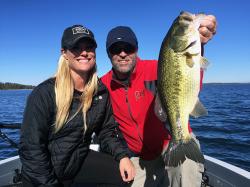
Mandy Ulrich and TV host Steve Pennaz
Pro bass angler Mandy Ulrich and TV host Steve Pennaz hoist the spoils of fishing jerkbaits in cold water.
This past February, on a bitter cold morning better suited for hot coffee and a roaring fire, I met Elite BASS Pro Chad Grigsby at a just-opened Perkins to outline our plans for taping an episode of “Lake Commandos.”
The air temperature was 22 degrees when we finally launched the boat, and water temp on my graph varied from 36 to 42 degrees depending on our location on the river.
The Commando format is simple: Each angler picks a pattern before getting on the water, and then we see who catches the most fish. For this particular show Chad picked a great year ’round smallmouth pattern: 3.5-inch Berkley Power Tubes while I picked jerkbaits, specifically the new Cutter 110+.
For the next three hours we struggled to put a fish in the boat. I had one fish hooked on the tube, but lost it, and after we switched to jerkbaits it was clear we were doing something wrong.

Cutter 90+ in Chameleon Vapor pattern
Berkley’s new Cutter 90+ in Chameleon Vapor pattern.The 3.5-in., 3/8 oz. bait is the smallest in the three-model jerkbait family.
A series of tweaks fixed that.
Our first move was to downsize from the Cutter 110+ to the 90+. Secondly, we dropped anchor so we could slow our retrieves. The final tweak was the final puzzle piece: we cast downstream or quartering and slowed our retrieves to a crawl.
And we started to catch smallmouths…a lot of smallmouths. But the funny thing was, I was catching small fish and Chad was catching big fish.
What Chad had figured out was key: cast directly downstream and allow the current to work the bait. He’d jerk it two or three times to move the bait forward and then he’d let the current wash it back on a semi-slack line. As a result, he was getting the big fish – 3s, 4s and 5s – while I was getting the 15 and 16 inchers. The big fish simply weren’t going to chase a faster retrieve.
At one point, Chad put his rod down to net a fish for me, leaving his bait to essentially wash in the current a bit. When he went back to pick up the rod, there was a fish on it!
This should have been a lesson for me to slow down, but at that point it was too late in the day, and we wrapped the show. I caught more fish, but Chad whipped me in total weight.
Another lesson learned: There are times when you can fish a bait wrong by fishing it too fast – especially jerkbaits.

Steve Pennaz
Years ago Steve Pennaz fished a “jerkbaits only” tournament on Lake of the Ozarks, an experience that taught him numerous lessons. These days, he keeps a jerkbait rod rigged and ready at all times.
If you want to become a better jerkbait angler, here are some things that will improve your success.
Lesson #1: Down, down, down!
Some anglers have the tendency to fish jerkbaits by moving the rod horizontally, even vertically. Actually, its better to fish jerkbaits by moving the rod tip in downward sweeps from roughly the 3:00 o’clock to 5:00 o’clock position. Quick rips at the beginning of your retrieve will help your bait reach your target depth zone sooner, and subsequent strokes and pauses will keep the neutrally-buoyant bait more or less on a horizontal retrieve toward the boat.
Lesson #2: Slack is good
Introduce slack line between the lure and the rod tip before you start the actual jerk-stroke down and immediately after. The introduction of slack line produces more erratic lure action and allows the bait to glide naturally after the stroke. You want to hear “tsst, tsst, tsst” during each cast.
Lesson #3: Cadence
I quickly learned that the right cadence and stroke combination is key to jerkbait fishing. During our filming, water was cold and bass did not want the baits fished fast; the pause was key, those moments in the retrieve when the bait would just sit in the water column, neutrally buoyant. Instead of a pop, pop, pop, and pause – or even two pops and a pause – it was a single stroke followed by a pause that got bites.
Lesson #4: Painfully long pauses
As a general rule of thumb, the colder the water, the slower you should fish a jerkbait. There may be times when you need to pause 10, 20, 30, or even 50 seconds between jerk-strokes. It’s painful to fish that way—and I hate it—but sometimes that’s the only way you’re going to get bit in cold water. Other times, fish may want the bait fished more aggressively.
Lesson #5: Apples and oranges
The best way to fish a jerkbait can also depend on target species. In this particular tournament we were targeting largemouths, and I mention that because smallmouths and largemouths seem to react differently to how jerkbaits are fished. In some cases it can really be apples and oranges. My experience is smallmouths typically want the bait fished with more aggressive strokes, while largies prefer jerkbaits fished slow. Still, on most days, you’ll need to let the fish tell you what you what they want.
Lesson #6: Rod Length
I’m 6′ 2″ and I fish out of a Ranger 620FS, so I’m a little higher off the water when I’m fishing off the deck. So, depending on your height and your boat, the key is to look for a rod that is long enough that you can fish the bait with a downstroke without the rod tip getting wet. My go-to rod (an Abu Villain) measures 7 feet and features a soft tip. I like a long rod; I can pick up line faster, and it gives me a little more control of the fish during the fight.
Lesson #7: Rod power/action
For larger jerkbaits, I prefer a medium-power baitcasting rod, which is 90% of the time. But for finesse situations in clear, heavily-pressured waters, I will step down in bait size and use a spinning rod. But no matter which you choose, the rod should have enough backbone to move the jerkbait. I like a 7′ medium-action rod with a softer tip, which allows slower bait movement at the start of each rip (doesn’t seem to spook as many fish). A softer tip is more forgiving with hooked fish; you’ll land more fish.
Lesson #8: Line choice
I’m usually throwing jerkbaits on 8-, 10- or 12-lb. Berkley Trilene 100% Fluorocarbon. First, it’s a little stiffer than mono to prevent the bait from hooking itself on your line. Secondly, because fluorocarbon sinks, that little extra weight can help keep baits down. Lastly, the near-invisibility of fluorocarbon puts the odds in your favor on clear waters. Fish that move 10, 20, 30 feet or more to hit a bait can be line shy.
The exception to the rule comes when fishing long pauses. There may be times when heavier fluoro can cause certain baits to nose-dip. In those cases, I may switch to neutrally-buoyant monofilament to keep baits horizontal.
Lesson #9: Examine how fish are hooked

Cutter 110+
Berkley’s new Cutter 110+ in Black Silver pattern. The 4 3/8-in., 9/16 oz. bait is the largest, beefiest bait in the new jerkbait family.
Which jerkbait hook you catch the fish on can tell you a lot. If you’re catching bass barely hooked via the rear jerkbait hook, chances are fish aren’t in love with what you’re doing. So, you may want to look at your presentation. Are you fishing with the right color? Am I fishing it too fast? Not fast enough? The best bites are those when the front or front and rear hooks end up in the bass’ mouth. I’ll start by trying different colors if I get several fish on the back hook.
Lesson #10: Colors
In clear water, I like more natural patterns, those translucent finish options in silver or natural forage patterns. But there are times when it seems smallmouths react better to bright baits with chartreuse and oranges. So, start with more natural patterns and see what the fish prefer.
Lesson #11: Bait choice
There are a lot of great jerkbaits on the market, but I’m most excited about Berkley’s new Cutter Series, designed by David Fritts, and fished by pros like Justin Lucas, Josh Bertrand, Gary Klein and Scott Suggs.
Unlike most jerkbaits, the three baits in the Cutter Series feature a coffin-style bill—a complete departure from traditional jerkbait design—for an action all their own. It’s almost like an underwater walk-the-dog with a slight side-to-side roll. And bass crush ’em.
The Cutter 110+ is a beefy, standard-size jerkbait; the Skinny Cutter 110+ has a similar length but thinner profile; and the Cutter 90+ has only two treble hooks — the perfect jerkbait for finesse situations. Each comes in 12 finishes and features Berkley’s new Fusion 19 hooks, which are sticky sharp.
My go-to bait is the 110+ but there are times when downsizing to the 90+ is simply the best way to get bit.
Parting Thoughts

Skinny Cutter 110+
Berkley’s new Skinny Cutter 110+ in Gilly pattern. The 4 3/8-in., 7/16 oz. bait is a perfect “in between” size jerkbait for both largemouths and smallies.
Really, the best way to learn how to fish a jerkbait is to leave the dock with a small sample of jerkbaits – and commit to yourself to fish only those baits for the day. It’s even better to have two anglers in the boat: one fishing fast, the other fishing slow; one fishing natural colors, the other bright colors; one fishing a larger bait, one a smaller bait; and so forth.
What will happen is you’ll start figuring out little patterns in the patterns.
Finally, although we’re focused on early-season cold water right now, keep in mind that jerkbaits are incredibly versatile. Sure, they’re a great spring, fall and winter bait, but can perform in warm-water situations, too!
//
About Steve Pennaz
Steve Pennaz excels at finding and catching fish on new waters, a skill developed over 30 years of extensive travel in search of giant fish. His television series, Lake Commandos, Man vs. Lake vs. Man, helps anglers understand the steps to building successful patterns on the water.
